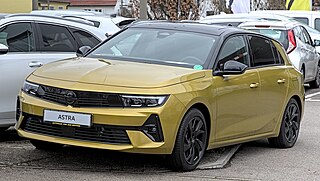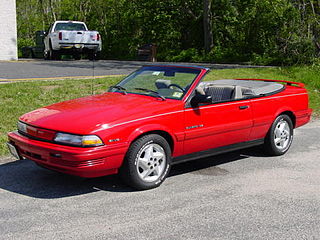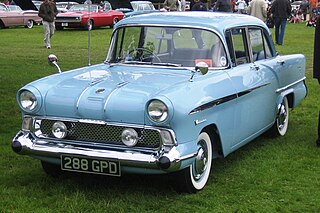
Pontiac, or formally the Pontiac Motor Division of General Motors, was an American automobile brand owned, manufactured, and commercialized by General Motors. It was originally introduced as a companion make for GM's more expensive line of Oakland automobiles. Pontiac quickly overtook Oakland in popularity and supplanted its parent entirely by 1933, in turn establishing its position as one of GM's dominant divisions.

The Vauxhall Viva is a small family car that was produced by Vauxhall in a succession of three versions between 1963 and 1979. These were designated the HA, HB and HC series.

The Opel Astra is a compact car/small family car (C-segment) developed and produced by the German automaker Opel since 1991, currently at its sixth generation. It was first launched in September 1991 as a direct replacement to the Opel Kadett. As of 2021, the car slots between the smaller Corsa supermini and the larger Insignia large family car.

The Pontiac Sunbird is a model line that was manufactured and marketed by Pontiac from the 1976 to the 1994 model years. Loosely deriving its name from the Pontiac Firebird, the Sunbird was introduced as the eventual replacement for the Pontiac Astre, replacing it entirely in 1978 as the smallest Pontiac.

The Chevrolet Chevette is a front-engine, rear-drive subcompact manufactured and marketed by Chevrolet for model years 1976–1987 as a three-door or five-door hatchback. Introduced in North America in September 1975, the Chevette superseded the Vega as Chevrolet's entry-level subcompact, and sold 2.8 million units over 12 years. The Chevette was the best-selling small car in the U.S. for model years 1979 and 1980.

The Pontiac Catalina is a full-size automobile produced by Pontiac from 1950 to 1981. Initially, the name was a trim line on hardtop body styles, first appearing in the 1950 Chieftain Eight and DeLuxe Eight lines. In 1959, it became a separate model as the "entry-level" full-size Pontiac.

The Opel Omega is a executive car engineered and manufactured by German automaker Opel between 1986 and 2004. The first generation, the Omega A (1986–1994), superseded the Opel Rekord. It was voted European Car of the Year for 1987, and was available as a saloon or estate. The second generation, the Omega B, was manufactured from 1994 to 2004.

The Chevrolet Cavalier is a line of compact cars produced by Chevrolet. Serving as the replacement of the Chevrolet Monza, the Cavalier was the second Chevrolet model line to adopt front-wheel drive. Three versions of the Cavalier have been sold, including three generations sold in North America from model years 1982 to 2005, a version produced by SAIC-GM for China from 2016 to 2021, and a SAIC-GM version produced for Mexico since the 2019 model year.

The Holden Torana is a mid-sized car that was manufactured by Holden from 1967 to 1980. The name apparently comes from a word meaning "to fly" in an unconfirmed Aboriginal Australian language. The original HB series Torana was released in 1967 and was a four-cylinder compact vehicle closely based on the British Vauxhall Viva HB series of 1966–1970.

The Pontiac LeMans is a model name applied to automobiles marketed by Pontiac. The name came from the French city of Le Mans, the site of the 24 Hours of Le Mans, the world's oldest active sports car endurance race that began in 1923. Originally a trim upgrade package based on the Tempest, the LeMans became a separate model in 1963.

The Pontiac Trans Sport is a minivan that was marketed by Pontiac from the 1990 to 1999 model years. The first minivan marketed by the division, the Trans Sport marked the beginning of a wider transition of moving away from sedans and station wagons as family-oriented vehicles. Marketed between the Chevrolet Lumina APV and the Oldsmobile Silhouette took its name from a similar 1986 concept vehicle.

The Oldsmobile Cutlass Ciera is a mid-size car manufactured and marketed for model years 1982-1996 by the Oldsmobile Division of General Motors — over a single generation. Body styles included a 2-door coupe, 4-door sedan, and the 4-door wagon.

The Pontiac Parisienne is a full-size rear-wheel drive vehicle that was sold by Pontiac on the GM B platform in Canada from 1958 to 1986 and in the United States from 1983 to 1986. Right-hand drive models were locally assembled in Australia, New Zealand, and South Africa until 1969. For most of its run, the Canadian Parisienne was nearly mechanically identical to the American Chevrolet Impala or Chevrolet Caprice. The Parisienne wagon continued under the Safari nameplate until 1989. Parisienne or La Parisienne means a grammatically female person or thing from Paris, France.

The Vauxhall Victor is a large family car produced by Vauxhall from 1957 until 1976. The Victor was introduced to replace the outgoing Wyvern model. It was renamed Vauxhall VX Series in 1976 and continued in production until 1978, by which time it had grown significantly and was viewed, at least in its home market, as a larger-than-average family car.

Meteor was a marque of automobiles offered by Ford Motor Company of Canada from 1949 to 1976. The make was retired for the 1962 and 1963 model years, when the name was used for the Mercury Meteor sold in the United States. It succeeded the Mercury 114, a Canadian-market Mercury based on the Ford, the "114" name being taken from the car's wheelbase.

The Daewoo Lacetti is a compact car manufactured and marketed globally by GM Korea since 2002. The first-generation Lacetti was available as a four-door sedan and five-door station wagon, styled by Pininfarina—and five-door hatchback styled by Giorgetto Giugiaro. The sedan and wagon were marketed as the Daewoo Nubira in some European markets and as the Suzuki Forenza in North America. The hatchback, was introduced in 2004 and marketed as Daewoo Lacetti5 in South Korea, Suzuki Reno in the United States. After the 2004 model year, it was marketed as Chevrolet Nubira and Lacetti in Europe, as the Chevrolet Optra in Canada, Latin America, Africa, Middle East, India, Japan and Southeast Asia, and as the Holden Viva in Australia and New Zealand.

The GMC Sprint is a coupe utility/pickup that was produced by GMC for the 1971–1977 model years. The Sprint was renamed Caballero for the 1978 model year, and produced through 1987. The rear-wheel-drive car-based pickups were sold by GMC Truck dealers primarily in the United States and Canada as the GMC version of the Chevrolet El Camino. Trim designations, emblems, and wheel trim differentiate the GMC from the Chevrolet. The vehicles were built on the General Motors A platform through 1981; for 1982, it was re-designated the G platform as the A platform switched to front-wheel drive.

Chevrolet Nomad is a nameplate used by Chevrolet in North America from the 1950s to the 1970s, applied largely to station wagons. Three different Nomads were produced as a distinct model line, with Chevrolet subsequently using the name as a trim package.

The Holden Special is a mid-size car that was manufactured by Holden for Australasia. Introduced as the top-level trim in the new Holden FJ range of 1953, the Special was complemented by the entry-level Holden Standard and the mid-range Holden Business. The Business was in fact already available, introduced in July 1953 in the 48 series first seen in 1948. Three months later, the FJ was introduced, therefore forming a three-model lineup based around one car. A "Standard"-type variant also existed in the 48 series, but had been marketed simply as the "Holden".
General Motors New Zealand Limited, is a subsidiary of General Motors that distributes GM' motor vehicles, engines, components and parts in New Zealand.























